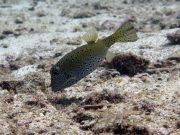Dykning med Boxfiskar
Lanta Marina Liv | Ostraciidae
Boxfiskar är, som namnet antyder, boxformade, med en bepansrad och stel kropp som i de flesta fall skulle hindra rörelseförmågan. Denna nackdel kompenseras av boxfiskens form, som har lett till utvecklingen av en ovanlig simstil.
De ses ofta på sandbankar eller stenblock nära revkanten under dykturer på Koh Lanta.
Boxfish är normalt ensamma djur som samlas på våren i små grupper bestående av 1 hane och 2–4 honor för fortplantning.
Alla dokumenterade arter av boxfiskar använder sig av en lekstrategi som kallas ”spawning rise”. Vid solnedgången eller soluppgången tillbringar hanen sin tid med att blinka med starka färger och dansa runt honan. När honan är nöjd simmar hon snabbt upp till ytan eller till grunt öppet vatten (rise), och hanen surrar då till honan, tillräckligt högt för att en dykare ska kunna höra det. Äggen befruktas och släpps sedan, och boxfiskarna återvänder till säkrare, skyddade delar av revet.
Denna pelagiska lekteknik innebär att äggen, när de väl släppts ut, sprids kraftigt av strömmarna ut i det öppna havet. Honan kan producera ett antal ägg dagligen under ungefär en månad. En fördel med denna teknik är att rovdjur inte kan äta upp hela äggkläckningen, men chansen att ett kläckt ägg driver till en lämplig plats där det nykläckta ungen kan leva och överleva är liten, vilket leder till en hög dödlighet vid reproduktionen av boxfiskar.
3 arter finns på denna sida:
Yellow Boxfish
(Ostracion cubicus)
The Yellow Boxfish (Ostracion cubicus) is a species of boxfish found in relative shallow waters, usually among corals and complex structures which can provide protection from potential predators.
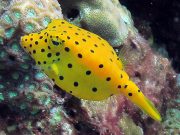
Ostracion cubicus @ Koh Haa
When juvenile, the Yellow Boxfish is bright yellow in color with black spots, and easy to identify. As they begin to mature the number of spots decreases and the yellow blends into almost a dirty, mustard colour.
Very old specimens will have blue-grey to black colouration with faded yellow. As they grow, the body elongates and a bump forms on the snout tip.
Juvenile - Bright yellow with black spots on head and body. Possibly starting to grow a small bump on snout tip.
Young Adult - Yellowish brown to olive coloured, with black spots on the head and a few dark ringed bluish spots on the body. Young adults will have a small bump on the snout tip.
Intermediate Adult - Tan to yellowish brown colour with dark ringed bluish spots. Fins are blue with black spots and may have blue/black or yellow crinkled line markings on the head and base of the pectoral fins. Obvious bump on the snout tip.
Large Adult - Brownish purplish or blue/greyish with indistinct/faded spots. Often yellow crinkled line markings on the head and yellowish tail base. Bump on the snout tip. Can reach a maximum length of 45 centimetres (18 in).
The Yellow Boxfish feeds mainly on algae, but will also feed on sponges, crustaceans and molluscs. The fish's diet consists of marine algae, worms, crustaceans, molluscs, and small fish. Using its puckered lips, it blows small bursts of water at the corals and sand to reveal anything that might be hiding.
When stressed or injured the Yellow Boxfish releases the neurotoxin tetrodoxin (TTX) from special cells covering their entire skin. This cloud of poison can be fatal to fish in the surrounding waters. The bright yellow colour and black spots are also a form of warning coloration (Aposematism) to any potential predators.
Horn-nosed Boxfish
(Ostracion rhinorhynchos)
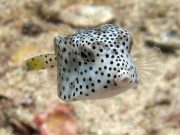
Ostracion rhinorhynchos @ Koh Bida
The Horn-nose Boxfish has a carapace that is pentagonal (six sides) in cross-section. The body ridges are relatively sharp-edged, and lack spines. There is a distinct bump on snout.
This species is whitish with black spots on the back and caudal peduncle. Large fish are darker with more dark spots.
This is a generally uncommon species and is found singly or in pairs over channels, coral patches and rubble substrates of sandy lagoons and sheltered inner reefs.
Feeds on benthic invertebrates.
Whitespotted Boxfish
(Ostracion meleagris)
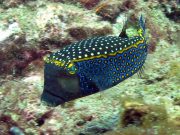
Male Ostracion meleagris @ Koh Bida
The male Whitespotted Boxfish has a black back with white spots and blue sides with bright yellow spots and bands.
Female and juvenile Whitespotted Boxfish have a black or dark brown body with white spots.
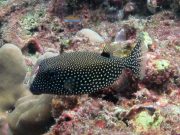
Female Ostracion meleagris @ Koh Haa
The Whitespotted Boxfish grows to 25 cm. The diet includes molluscs, bristle worms, sponges, crustaceans and algae.
Dykning med Boxfiskar runt Koh Lanta
Dykning och Snorkelutflykter
Om du vill ha en chans att se Boxfiskar på en av våra dagliga högsäsongs dykresor från Koh Lanta, skicka oss ett e-postmeddelande till info@diveandrelax.com.
Följ med på våra dykresor med speedboat under högsäsong till några av Thailands bästa dykplatser och njut av små grupper, korta restider och fokus på personlig service, säkerhet och nöje.
Är du ännu inte certifierad dykare? Lär dig att dyka på Koh Lanta med den 3-dagars SSI Open Water Diver-kursen.
Boka online och spara 10 % på dykresor och dykkurser på Koh Lanta.
Ta Reda på Mer
Guider för Marina Djur och Växter i Indo-Stilla Havet
- Allen, G., Steene, R., Humann, P., DeLoach, N. (2003) Reef Fish Identification, Tropical Pacific. Jacksonville, FL., USA: New World Publications, Inc., ISBN 1-878348-36-1.
- Humann, P., DeLoach, N., (2010) Reef Creature Identification, Tropical Pacific. Jacksonville, FL., USA: New World Publications Inc., ISBN 978-1-878348-44-9
- Debelius, H. (2013) Indian Ocean Reef Guide. Frankfurt, Germany: IKAN - Unterwasserarchiv, ISBN 978-3-939767-52-7.
- Debelius, H. (2004) Nudibranchs and Sea Snails, Indo-Pacific Field Guide. Frankfurt, Germany: IKAN - Unterwasserarchiv, ISBN 3-925919-51-1
- Erhardt, H., Knop, D. (2015) Corals Indo-Pacific Field Guide. Frankfurt, Germany: IKAN - Unterwasserarchiv, ISBN 3-925919-69-4.
- Veron J.E.N., Stafford-Smith M.G., Turak E. and DeVantier L.M. (2016). Corals of the World


